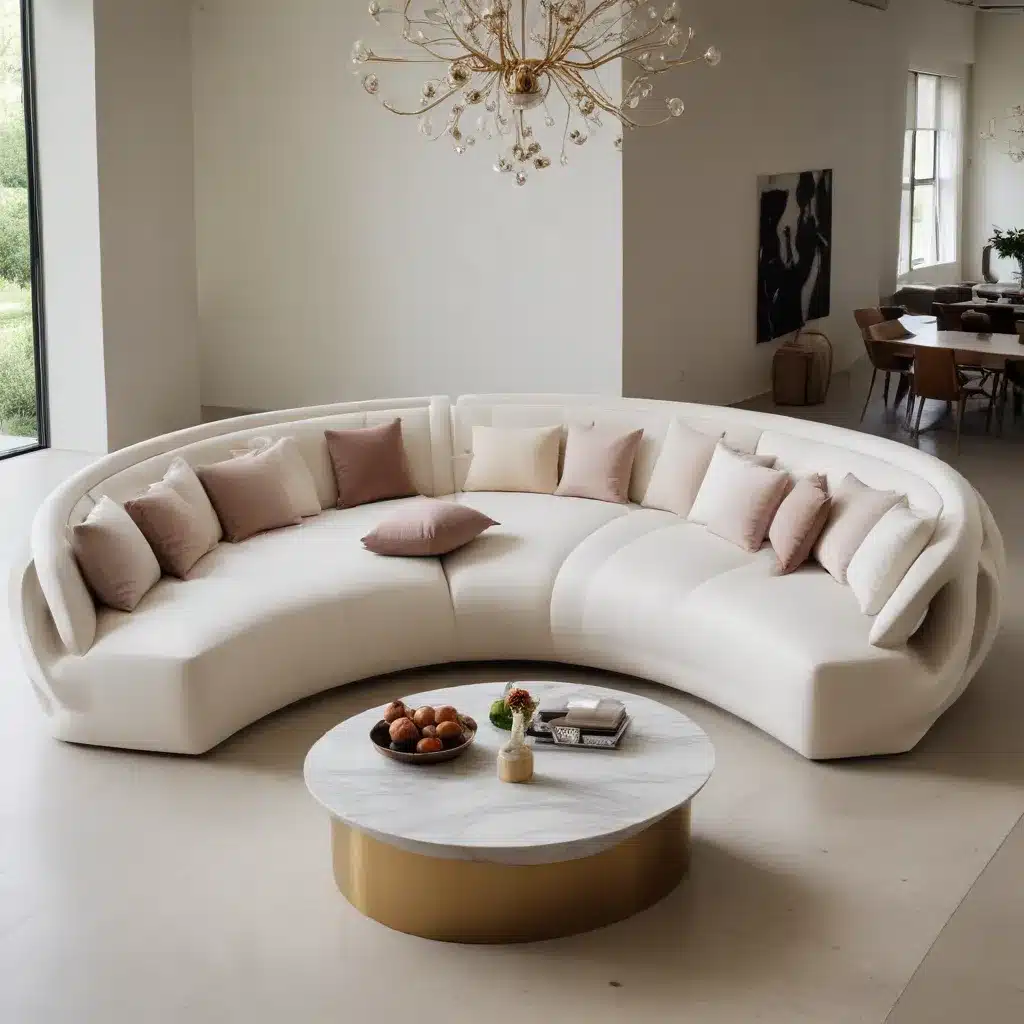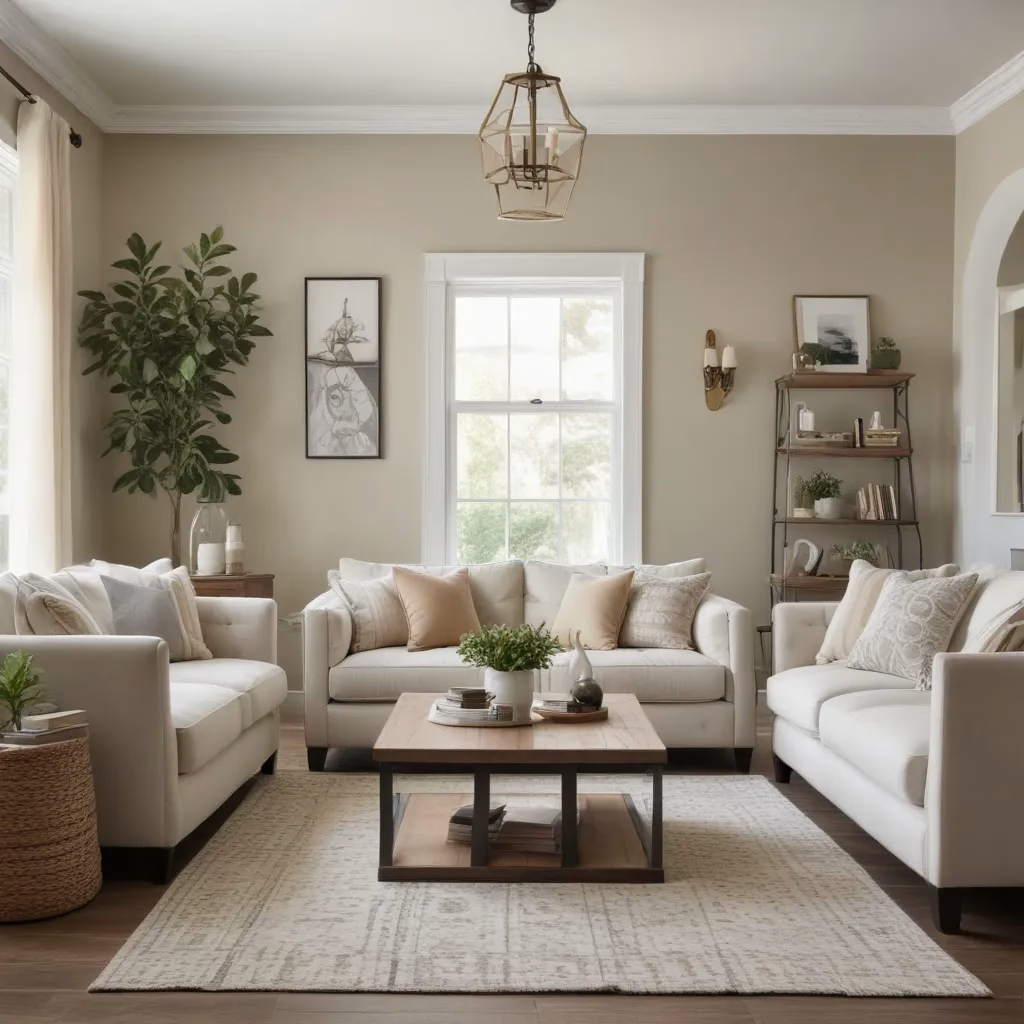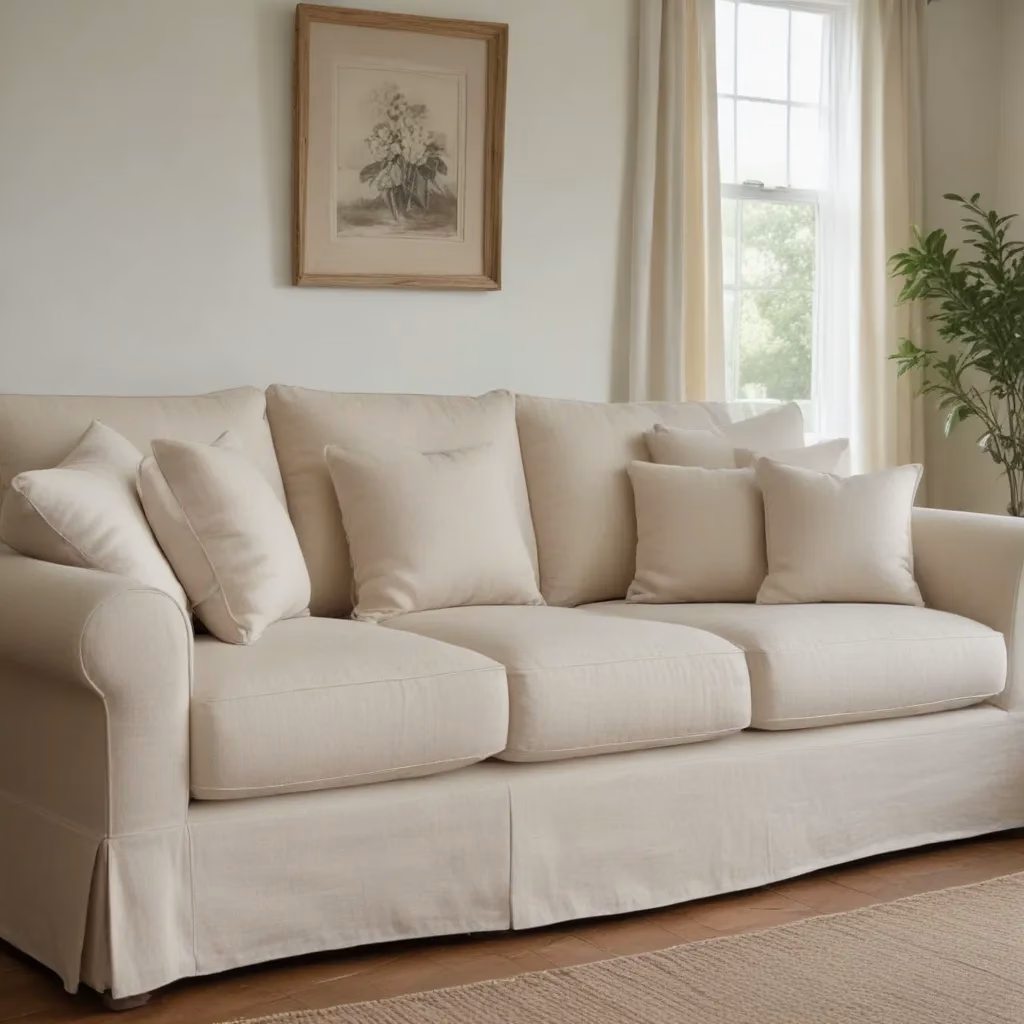
The Rise of Statement Seating in Modern Interiors
As a furniture specialist with over two decades of experience, I’ve witnessed firsthand the evolution of sofa design. Gone are the days when sofas were merely functional pieces tucked against the wall. Today’s sculptural sofas have become true works of art, commanding attention and serving as the focal point of contemporary living spaces.
The trend towards statement seating reflects a broader shift in interior design philosophy. Homeowners and designers alike are moving away from the idea that furniture should blend into the background. Instead, there’s a growing appreciation for bold, eye-catching pieces that spark conversation and define a room’s character.
I’ve had the pleasure of working with clients who’ve transformed their living rooms with a single, well-chosen sculptural sofa. The impact is often dramatic – a space that once felt generic suddenly pulses with personality and style. It’s not just about aesthetics, though. These sofas often incorporate innovative ergonomic designs, marrying form and function in exciting new ways.
Characteristics of Sculptural Sofas
What sets sculptural sofas apart from their more traditional counterparts? In my experience, it comes down to a few key elements:
-
Unconventional shapes: Think curved silhouettes, asymmetrical designs, and organic forms that break free from the typical boxy sofa structure.
-
Unique materials: Many sculptural sofas incorporate unexpected materials like molded plastics, bent wood, or even concrete, pushing the boundaries of what we consider “upholstery.”
-
Bold colors: While neutral tones have their place, many sculptural sofas embrace vibrant hues or striking color combinations to further enhance their visual impact.
-
Artistic details: Intricate stitching, unusual textures, or sculptural elements that extend beyond the seating area itself are common features.
-
Modular versatility: Some sculptural sofas offer modular components that can be rearranged, allowing for dynamic and adaptable seating arrangements.
I’ve found that these characteristics often work in harmony to create pieces that are as much art installations as they are functional seating options. The best sculptural sofas manage to strike a balance, offering comfort without compromising on their artistic vision.
Integrating Sculptural Sofas into Your Space
One of the most common questions I receive from clients is how to incorporate a sculptural sofa into an existing interior design scheme. It’s a valid concern – these pieces can be so visually striking that they run the risk of overwhelming a space if not handled thoughtfully. Here are some tips I’ve developed over the years:
-
Let it be the star: When you have a truly exceptional sculptural sofa, allow it to take center stage. Keep other furnishings and decor elements relatively simple to avoid visual competition.
-
Consider scale: Ensure the sofa’s size is appropriate for your room. A massive, swooping design might look stunning in a showroom but could feel oppressive in a smaller living space.
-
Play with contrast: If your sculptural sofa features bold colors or patterns, consider balancing it with neutral walls and flooring. Conversely, a more subdued sofa can pop against a colorful accent wall.
-
Think about traffic flow: Sculptural sofas often have unconventional shapes that can impact how people move through a space. Ensure there’s adequate clearance around the piece for comfortable navigation.
-
Complement with lighting: Strategic lighting can enhance the dramatic effect of a sculptural sofa. Consider statement pendant lights or artistic floor lamps that echo the sofa’s design elements.
By following these guidelines, you can create a cohesive look that celebrates your sculptural sofa without letting it overpower the room. Remember, the goal is to create a harmonious space that reflects your personal style while showcasing the sofa’s unique design.
Popular Styles in Sculptural Sofas
Over the years, I’ve observed several distinct styles emerge within the world of sculptural sofas. Each has its own unique characteristics and appeals to different aesthetic sensibilities. Here are some of the most popular styles I’ve encountered:
1. Organic Curves
Sofas featuring sinuous, flowing lines that mimic natural forms have gained significant traction. These pieces often evoke a sense of movement and fluidity, creating a soft, welcoming atmosphere in a room. I’ve seen stunning examples that resemble rolling hills or gentle waves, bringing a touch of the outdoors inside.
2. Geometric Precision
On the other end of the spectrum are sofas that embrace sharp angles and precise geometric shapes. These designs often draw inspiration from modernist architecture and abstract art. They can lend a space a sense of order and sophistication, appealing to those who appreciate clean lines and mathematical precision.
3. Modular Marvels
Modular sculptural sofas have become increasingly popular, especially among clients who value flexibility. These pieces typically consist of individual sections that can be rearranged to create different configurations. I’ve worked with modular systems that allow users to transform their sofa from a traditional linear arrangement to a circular conversation pit with just a few adjustments.
4. Suspended Designs
One of the most intriguing trends I’ve noticed is the rise of suspended or “floating” sofas. These pieces appear to defy gravity, often supported by hidden structures or cantilevered designs. They create a sense of lightness and can make a space feel more open and airy.
5. Mixed Material Masterpieces
Sofas that combine multiple materials in unexpected ways have become a hallmark of contemporary sculptural design. I’ve seen stunning pieces that juxtapose plush upholstery with sleek metal frames, or incorporate elements like glass or stone. These mixed-material designs often serve as a bridge between different style elements within a room.
Each of these styles offers unique possibilities for creating a statement piece in your living space. When helping clients choose, I always encourage them to consider not just the visual appeal, but also how the sofa’s style aligns with their lifestyle and the overall feel they want to create in their home.
The Impact of Color in Sculptural Sofa Design
Color plays a crucial role in the world of sculptural sofas, often serving as the element that transforms a unique shape into a true showstopper. In my years of experience, I’ve seen how the right color choice can elevate a sculptural sofa from interesting to unforgettable. Here’s a deeper look at the role of color in these statement pieces:
Bold Monochromatics
One trend that has stood the test of time is the use of bold, saturated colors in a monochromatic scheme. A sculptural sofa in a vibrant hue like emerald green, sapphire blue, or sunset orange can become the centerpiece of a room, especially when set against neutral backgrounds. I’ve had clients who’ve built entire room designs around the color of their statement sofa.
Subtle Neutrals
While bold colors often get the spotlight, I’ve also seen stunning sculptural sofas in more subdued tones. Soft greys, warm beiges, and crisp whites can emphasize the sofa’s unique form without overwhelming the senses. These neutrals are particularly effective when the sofa features intricate textures or when you want to highlight the interplay of light and shadow on the piece’s curves.
Color Blocking
Some of the most innovative sculptural sofas I’ve encountered use color blocking to accentuate their unique shapes. This might involve contrasting colors on different sections of the sofa or gradients that flow along its curves. Color blocking can add an extra layer of visual interest and help define the sofa’s sculptural elements.
Unexpected Color Combinations
Daring color pairings can take a sculptural sofa to the next level. I’ve worked with designers who’ve created sofas that combine colors you might not expect to see together – like dusty pink and forest green, or mustard yellow and deep purple. When done right, these unexpected combinations can be absolutely stunning.
Textural Color Play
It’s not just about the hue itself, but also how color interacts with texture. I’ve seen sculptural sofas where the color seems to shift and change depending on the angle of view or the light in the room. This effect is often achieved through the use of materials like velvet, which can appear to change color as you move around it.
When advising clients on color for their sculptural sofas, I always emphasize the importance of considering the piece in the context of their entire space. The right color can tie a room together, create a focal point, or even influence the mood and energy of the space. It’s a powerful tool in the world of interior design, and nowhere is this more evident than with sculptural sofas.
Maintenance and Care for Sculptural Sofas
Owning a sculptural sofa is like having a piece of functional art in your home. As with any investment piece, proper care and maintenance are crucial to ensure its longevity and preserve its beauty. Over the years, I’ve developed a set of best practices for caring for these unique pieces:
Regular Cleaning
The first line of defense in maintaining your sculptural sofa is regular cleaning. However, the specific cleaning methods will depend on the materials used in your sofa’s construction. Here are some general guidelines:
- For fabric upholstery, vacuum weekly using a soft brush attachment to remove dust and debris.
- Leather sofas should be dusted with a dry cloth and occasionally treated with a leather conditioner.
- For sofas with hard surfaces (like wood or plastic components), use a microfiber cloth to remove dust.
Always refer to the manufacturer’s care instructions, as some sculptural sofas may require specialized cleaning methods.
Protecting from Sunlight
Many sculptural sofas feature bold colors or unique materials that can be sensitive to sunlight. Prolonged exposure can lead to fading or even structural damage in some cases. I always advise clients to:
- Position the sofa away from direct sunlight if possible.
- Use window treatments like UV-blocking curtains or films to protect your sofa when sunlight is unavoidable.
- Rotate cushions regularly to ensure even exposure and wear.
Addressing Spills Promptly
Accidents happen, but quick action can prevent permanent stains. Keep these tips in mind:
- Blot spills immediately with a clean, dry cloth. Don’t rub, as this can spread the stain and damage the fabric.
- For water-based spills on fabric upholstery, use a mild soap solution and blot gently.
- For oil-based stains, consult a professional cleaner as soon as possible.
- On leather, wipe spills immediately with a dry cloth and allow to air dry.
Professional Cleaning
While regular maintenance can be done at home, I recommend professional cleaning for sculptural sofas at least once a year. Professional cleaners have the expertise and equipment to deep clean without damaging the unique materials or structures of these pieces.
Structural Care
Sculptural sofas often have unique structural elements that require special attention:
- Regularly check and tighten any visible screws or bolts.
- For sofas with moving parts or modular components, ensure mechanisms are clean and well-lubricated.
- Be mindful of weight limits, especially for suspended or cantilevered designs.
Fabric Protection
For fabric upholstered sculptural sofas, consider applying a fabric protector. This can help repel stains and make cleaning easier. However, always test on an inconspicuous area first, as some protectors may alter the fabric’s appearance or texture.
By following these care guidelines, you can help ensure that your sculptural sofa remains a stunning centerpiece in your home for years to come. Remember, these pieces are often significant investments, both financially and in terms of your home’s aesthetic. A little regular care goes a long way in preserving their beauty and functionality.
The Future of Sculptural Sofa Design
As someone who’s been in the furniture industry for many years, I’m always excited to see how design trends evolve. When it comes to sculptural sofas, I believe we’re on the cusp of some truly innovative developments. Here’s my perspective on what the future might hold for these statement pieces:
Sustainable Materials
Sustainability is becoming increasingly important in all aspects of design, and sculptural sofas are no exception. I anticipate we’ll see more pieces incorporating eco-friendly materials such as:
- Recycled plastics and metals
- Sustainably sourced woods
- Bio-based foams and fabrics
These materials will likely be used in ways that highlight their unique properties, rather than trying to mimic traditional upholstery materials.
Smart Integration
As our homes become more connected, I expect to see sculptural sofas incorporating smart technology in creative ways. This could include:
- Built-in charging stations or wireless charging capabilities
- Integrated lighting systems that respond to touch or voice commands
- Temperature-regulating fabrics for optimal comfort
The key will be integrating these technologies seamlessly without compromising the sofa’s sculptural aesthetic.
Adaptable Designs
The trend towards multifunctional furniture is likely to influence sculptural sofa design. I foresee more pieces that can adapt to different needs and spaces:
- Modular designs that can be easily reconfigured
- Sofas with built-in storage solutions
- Pieces that can transform from seating to sleeping arrangements
These adaptable designs will appeal to urban dwellers with limited space and those who value versatility in their furniture.
Biophilic Influences
Biophilic design, which seeks to connect people with nature, is gaining traction in interior design. I believe we’ll see this reflected in sculptural sofa designs through:
- Organic shapes inspired by natural forms
- Integration of living elements, such as planters built into the sofa structure
- Use of natural, tactile materials that evoke a connection to the outdoors
Personalization and Customization
As technology advances, I anticipate more opportunities for personalized sculptural sofas:
- 3D-printed components that allow for truly unique designs
- Customizable modular systems that buyers can configure to their exact specifications
- Interactive design processes where customers can collaborate with designers in real-time
This level of customization will allow homeowners to have sculptural sofas that are truly one-of-a-kind and perfectly suited to their space and style.
Artistic Collaborations
I expect to see more collaborations between furniture designers and artists from other disciplines. This could lead to sculptural sofas that blur the line between furniture and art installation, potentially incorporating elements like:
- Kinetic sculptures
- Interactive digital displays
- Innovative use of light and shadow
These artistic collaborations could result in sofas that are not just seating options, but true conversation pieces that evolve and change over time.
As we look to the future of sculptural sofa design, one thing is clear: the boundaries of what we consider a “sofa” will continue to be pushed. These pieces will increasingly become focal points in our homes, reflecting our values, embracing technology, and challenging our perceptions of form and function. It’s an exciting time for design, and I can’t wait to see how these trends unfold in the coming years.
Conclusion: The Artistry of Sculptural Sofas
As we’ve explored throughout this article, sculptural sofas represent a fascinating intersection of art, design, and functionality. They’ve evolved from mere seating options to become true centerpieces, capable of defining a space and expressing personal style in bold, innovative ways.
From their unique shapes and materials to their bold use of color and integration of cutting-edge technologies, sculptural sofas continue to push the boundaries of furniture design. They challenge our preconceptions about what a sofa should be, inviting us to rethink our living spaces and how we interact with them.
As a furniture specialist, I’ve had the privilege of witnessing firsthand how these remarkable pieces can transform a room. They have the power to elevate an interior from ordinary to extraordinary, creating focal points that inspire conversation and admiration.
Whether you’re drawn to the organic curves of nature-inspired designs, the precise geometry of modernist creations, or the adaptable functionality of modular systems, there’s a sculptural sofa out there that can perfectly complement your aesthetic vision and lifestyle needs.
Remember, choosing a sculptural sofa is about more than just selecting a piece of furniture. It’s about making a statement, expressing your personality, and creating a living space that truly reflects who you are. With proper care and maintenance, these pieces can be enjoyed for years to come, evolving with your style and becoming cherished elements of your home.
As we look to the future, it’s clear that sculptural sofas will continue to evolve, incorporating new materials, technologies, and design philosophies. They’ll adapt to our changing needs and values, becoming even more integrated into our daily lives while maintaining their status as objects of beauty and wonder.
If you’re considering adding a sculptural sofa to your home, I encourage you to explore the wide range of options available. Take the time to find a piece that speaks to you, that excites your imagination and fits seamlessly into your life. After all, in the world of sculptural sofas, you’re not just choosing furniture – you’re choosing a work of art.
For more inspiration and expert advice on selecting the perfect sculptural sofa for your space, visit Sofa Spectacular. Our team is always ready to help you find the statement piece that will transform your home into a showcase of contemporary design.



